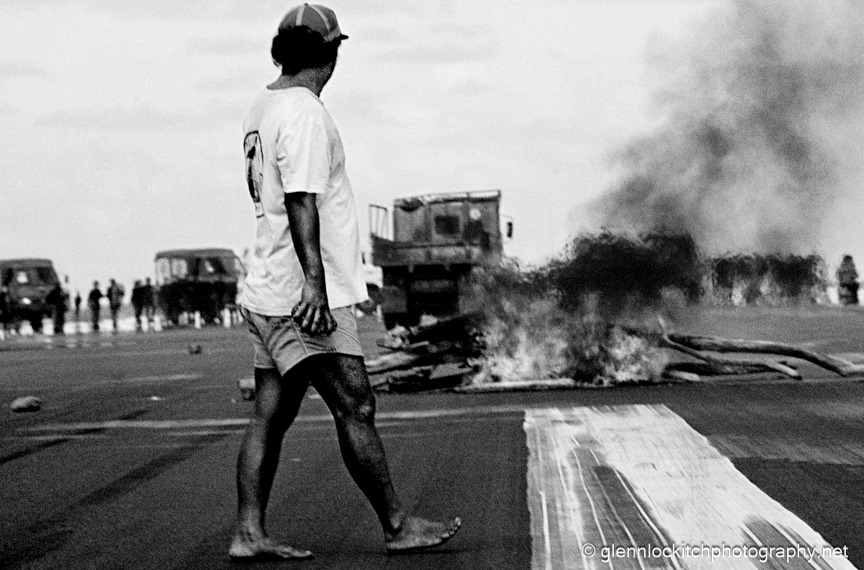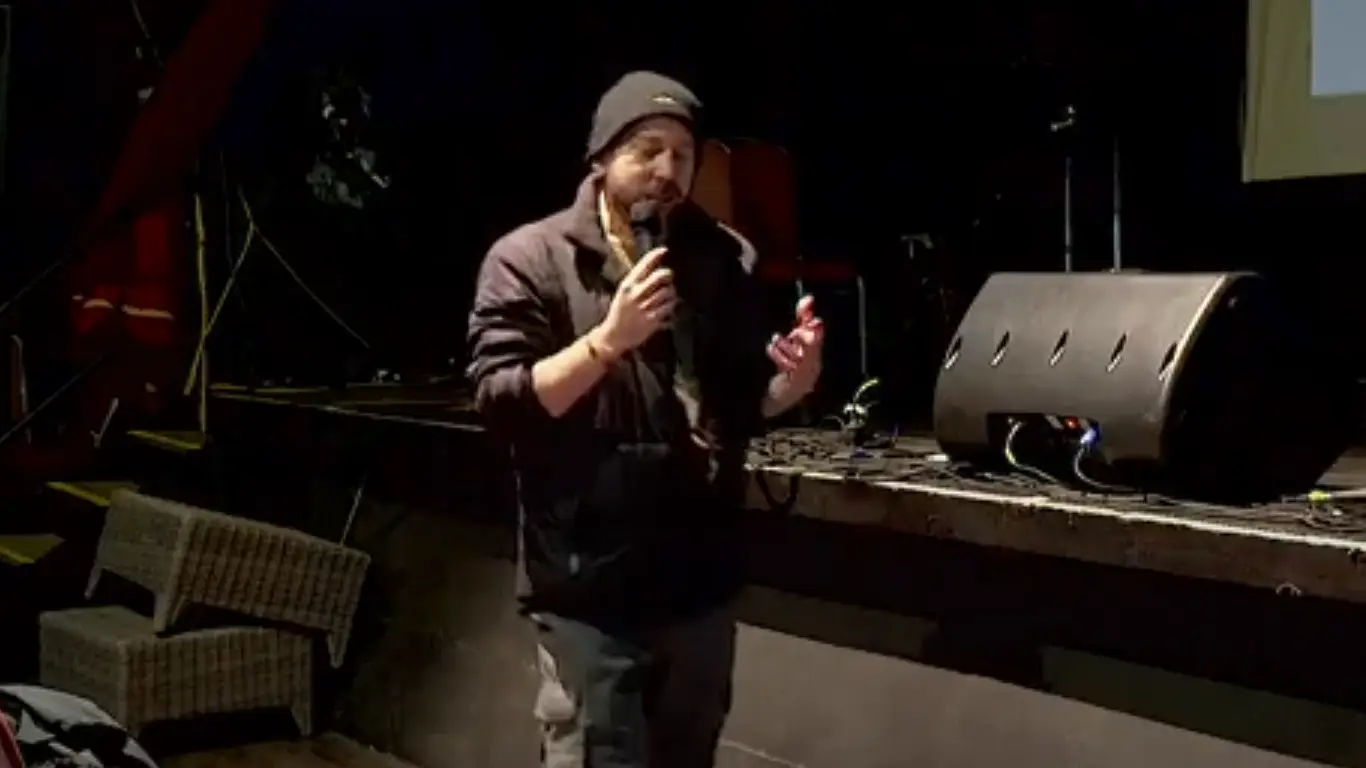
Video Transcript
I was picked up by Ian Cohen in his little Zodiac boat. He had a high-powered water pistol and was squirting some French sailors on another boat down the side of Garden Island. It was an interesting first-time experience being out there shooting, and I could see the Sydney Peace Squadron in action.
The police had a tactic — they’d grab the rope at the front of your canoe, tie it to the back of their speedboat, and tow you all the way to the other end of the harbour. By the time you paddled back, you’d lost 20–30 minutes.
Later, I went down to the South East forests of New South Wales in 1995 to photograph the blockades. The sheer number of logging trucks amazed me. At the first blockade, I came across three young women who were about to be arrested. They showed such courage and joy despite the circumstances. That first image I took in the forest blockade remains one of my most inspiring.
Richard Jones from the Democrats was there, and you could see loggers up the back, protesters in front. Police came in, warning that arrests were imminent. Protesters locked themselves to tripods on the road to Eden’s woodchip mill, blocking trucks for hours. Some even locked onto the police rescue vehicles, causing further delays — a tactic that hit them financially, which, in my experience, was often more effective than political arguments.
The tension was real — some loggers were aggressive, and in small towns, the police could be related to them, making it personal.
From the forests, I documented protests in Tasmania, and in Sydney, where demonstrators dressed up as a koala, a logger, and other characters in a political street performance outside the Forestry Commission. When the roller doors to the underground parking suddenly opened, the “animals” ran through, chased by the logger with a cardboard chainsaw, then by the police — a real-life Benny Hill scene ending with arrests in the car park.
I also photographed a young man locked to a tree in Taylor Square, Sydney — the same young man I’d met on his 16th birthday when he’d been capsicum sprayed.
Tahiti – French Nuclear Testing
When I heard about a planned peaceful march in Papeete, Tahiti, during the final stages of French nuclear testing, I scrambled money to get there. Air New Zealand initially said they couldn’t take a political stance, but a staff member privately arranged a ticket for me at wholesale price.
Once there, the atmosphere changed when the French tested the first underground bomb. Locals gathered at Parliament House, pulling on fences. The next day, Australian politicians and journalists were taken, supposedly, to a union meeting. Instead, we were dropped between Tahitian protesters armed with rocks, golf clubs, and bats, and French riot police with tear gas and rubber bullets. Riots broke out, the airport was burned, and 80 cars were torched in the car park.
One man posed for me holding a rock and Molotov cocktail. Another asked me for a lighter before setting cars ablaze. Sadly, when I returned to Australia, I lost 25 rolls of colour film after briefly leaving them unattended — a painful lesson in safeguarding work.
Philippines – Mining Impacts
In 1996, I travelled the Philippines with documentary filmmakers to record the impact of mining on Indigenous communities. On Negros Island, we saw massive toxic tailings dams containing cyanide, sitting at river junctions where locals fished, bathed, and drew water. One mine threatened to collapse while we filmed.
Communities with little food still welcomed us with lunch. We documented toxic sludge flooding rice fields, children with skin ailments, and rivers turned into poisoned roads. In Mindanao, we learned of Australian mining company Western Mining Corporation’s involvement in violence — after locals refused bribes, their village was attacked by warplanes and ground troops, leaving eight dead and 120 families displaced. Survivors shared harrowing stories of lost children.
Union Struggles – Maritime Dispute
In 1998, I photographed the Patrick Stevedores dispute, when the government and company tried to break the Maritime Union. I covered protests in Melbourne and Port Botany, Sydney. Union leaders like John Coombs fought the case in court, eventually winning. It was national news for months.
East Timor, Global Protests, and Reclaim the Streets
I documented the massive East Timor protests in 1998, global protest coordination through the early Indymedia network, and the J18 “global day of action” in 1999. Pre-social media, it was groundbreaking to upload photos and stories instantly to a worldwide audience.
World Economic Forum, Melbourne 2000
Around 20,000 people surrounded Crown Casino, blocking politicians and corporate delegates. Riot police used excessive force, sending hundreds to hospital. Many demonstrators were unarmed but suffered serious injuries — one student leader had ribs broken and later won a court case against the police.
Kalahari Bushmen, Botswana
I travelled with the Kalahari Bushmen to the High Court in their fight against eviction for diamond mining. It was the first time many had left the desert. Survival International supported their case, which they eventually won, regaining legal rights to their land.
Sea Shepherd Campaigns
I joined Sea Shepherd in Antarctica, photographing dangerous confrontations with Japanese whalers. On one mission, we captured the first photographic evidence of a whale killed in Australian Antarctic waters — released globally the day after the Japanese Prime Minister left Australia, creating an international incident.
Life onboard was harsh — freezing cold, storms, and isolation — but the wildlife encounters and successes in saving hundreds of whales made it worthwhile.
Aboriginal Deaths in Custody, Climate Protests, and Newcastle Coal Actions
I’ve documented constant protests over Aboriginal deaths in custody, many commemorating victims and demanding action on ignored Royal Commission recommendations.
I’ve also covered climate rallies, school strikes, and direct actions like the recent blockade of the Newcastle coal port, the largest in the world. Police made 53 arrests without warning, simply locking the gates on protesters.
Final Thoughts
Protest is essential in a democracy. Without it, voices are silenced. Whether in forests, cities, deserts, or oceans, I’ve seen the power of collective action — and the risks faced by those who stand up. My work is simply to document their courage, struggle, and hope.
Visit Glenn Locktich’s website:
glennlockitchphotography.net
